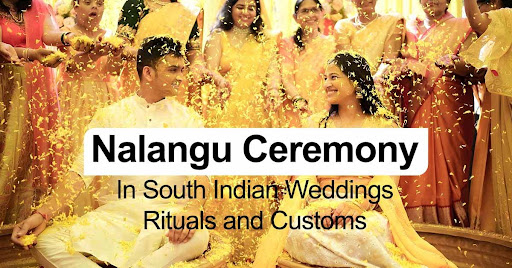If you’ve ever walked into a bright yellow courtyard on the morning of a wedding, you’ve probably seen the Nalangu Ceremony in full swing. The first thing you notice is the smell of turmeric. Then you hear cousins making fun of the bride or groom, and finally, aunties singing old wedding songs that have been passed down for generations. In many ways, this small but powerful ritual is the true heartbeat of a South Indian Wedding. At VRTM, we have watched countless families treat the Nalangu as sacred, no matter how modern their celebrations get.
Some people think of it as just smearing turmeric. But ask anyone who has sat through the event and they’ll tell you it is much more. The Nalangu Ceremony is a mix of purification, blessings, and play. It is like pressing the reset button before the big day, clearing away stress, bad vibes, and nerves, and replacing them with love and laughter.
Why families hold on to Nalangu
The Nalangu Ceremony may look simple on the surface, but its importance runs deep. The first purpose is cleansing. The turmeric, sandalwood, and herbal powders aren’t just about glowing skin. They symbolically wash away negativity and prepare the couple for the sacred wedding rites. The second purpose is blessings. When married women, or Sumangalis, apply the paste, they are passing on their lived experience and goodwill. The third is bonding. Weddings can be nerve-racking, especially arranged ones. This ritual is the lighthearted pause where laughter breaks the ice.
Because of its significance, many families make it the very first step in wedding planning. Securing a proper venue, often a kalyana mandapam in Chennai, ensures there is space not only for rituals but also for relatives, games, and songs.
Symbolism behind the yellow glow
Look closely during a Nalangu Ceremony and you’ll notice the ingredients are chosen with care. Turmeric, sandalwood, kumkum, oils, and even neem leaves sometimes. None of this is random.
- Turmeric (Manjal): The hero of the day. Apart from its medicinal properties, its golden color symbolizes prosperity, luck, and a bright future. Seeing the bride and groom glowing in that yellow paste feels like a sunrise announcing a new beginning.
- Nalangu Maavu: This is not the beauty pack you can buy at the store. People usually make it at home with chickpea flour, sandalwood, neem, and vetiver. It cleans, cools, and heals the skin, and it also acts as a ritual shield.
- Sandalwood and oils: These calm the mind and body, easing nerves. When rubbed on the skin, the coolness is almost like nature itself blessing the couple.
These things protect against the evil eye, and their smell makes the room feel clean.
Elders, songs, and shared laughter
It’s not just the food that makes the Nalangu Ceremony so special; it’s the people too. While singing songs, the Sumangalis lead the way and put on the paste. The songs are half blessing and half teasing, and they make older relatives feel nostalgic for the times they heard them when they were young.
Turmeric is more than just skin care. It is an elder saying, “May you have a long, happy marriage.” It is cousins laughing as they sneakily apply too much paste on the groom’s cheeks. It is that collective joy that binds families tighter.
Some even believe the ritual wards off bad planetary influences. Whether or not you take that literally, one thing is clear. The ceremony eases the heavy tension that usually builds before a South Indian Wedding.
When it happens and who takes part
Traditionally, the Nalangu Ceremony is performed either the night before or early in the morning of the wedding day. Some Telugu families hold it after the wedding as a fun, relaxed get-together. Timing changes with customs, but the intent stays the same.
The guest list is usually intimate. Mothers, sisters, aunts, and cousins gather around, though friends and younger relatives often join the fun part of the ritual. Nowadays, it’s common to see men and women taking part together. The laughter only grows louder when the rules are loosened a little.
For the bride and the groom
The bride’s Nalangu Ceremony is often more detailed. Her face, arms, and feet are anointed with turmeric and oil. Fresh flowers are placed in her hair, filling the air with fragrance. The most senior female relatives take the lead, passing on blessings for a stable and prosperous married life.
For the groom, the process is almost identical. A younger male relative usually sits beside him, representing continuity of family bonds. In modern setups, the couple often sits together, side by side, with friends from both sides joining in to smear turmeric and share jokes. It turns into a joint celebration, breaking down barriers.
How the ritual flows
The Nalangu Ceremony usually moves in a simple order:
- Welcome and seating: The couple sits on a decorated wooden plank with kolams on the floor and mango leaves overhead.
- Anointing by elders: Senior women begin with oil and turmeric paste, gently applying it to the couple’s face, hands, and feet.
- Family joins in: Relatives, cousins, and friends take turns. This is when things get playful, with turmeric smears often turning into laughter-filled mini battles.
- Fun games: Rolling coconuts, breaking dried appalams, or grabbing betel leaves from a pile. Each game carries a symbolic message but mostly it’s just about fun.
- Final blessing: Aarati is performed to ward off the evil eye, followed by the ceremonial bath known as Mangala Snanam.
Even with all these steps, the ceremony rarely lasts more than an hour. But every minute is rich in emotion.
The checklist every host needs
It’s not about spending a lot of money to plan a Nalangu Ceremony; it’s about getting the right things ready.
- Some important things are fresh turmeric, sandalwood, kumkum, and the nalangu maavu mix.
- Decorated mats, wooden planks or dais, marigold garlands, and banana leaves.
- Brass bowls for pastes, an Aarati plate with lime water, and oil lamps.
- Game props like coconuts, betel leaves, and dried appalams.
We often help families at VRTM make this list so they don’t forget anything important. A marriage hall in Chrompet is a great place to host a big event, especially if you plan to have games and music.
The fun side of Nalangu
For many younger relatives, the highlight of the Nalangu Ceremony is not the paste but the games. Rolling coconuts toward each other to test unity, breaking papads on the head just for laughs, or snatching betel leaves to see who is quicker. These moments may seem silly at first, but they help people get to know each other better, especially in arranged marriages where the couple may not know each other very well yet.
Couples often put modern spins on their weddings in cities. They may play Bollywood songs in the background, invite friends to join the smearing, or even have photographers set up candid photo booths.
Blending tradition with modern life
Metropolitan weddings sometimes have tight schedules. In such cases, families condense the Nalangu Ceremony into 30 minutes. Elders perform the main blessing, the couple is smeared with turmeric, one or two games are played, and then the Aarati is done. The core essence remains intact.
Inclusivity is also on the rise. Men, younger friends, and even non-Hindu relatives are encouraged to join the playful section of the ritual. It keeps the energy open and welcoming.
When guest lists grow, families often look for bigger venues. Spacious marriage halls in Kovilambakkam are increasingly popular for Nalangu because they allow tradition and convenience to blend seamlessly.
Respect, safety, and sensitivity
While the ritual is fun, respect for elders is key. The senior women must always lead the first anointing. Hygiene matters too. Families are advised to do a patch test with the paste, provide towels and water, and make sure everyone is comfortable. No one should feel forced to participate if they are shy or hesitant. A joyful and respectful environment is what truly defines a proper Nalangu Ceremony.
Conclusion
The Nalangu Ceremony might look like a lighthearted turmeric ritual, but it is one of the most powerful parts of a South Indian Wedding. It cleans, blesses, and connects. It’s where anxious energy turns into laughter, family bonds grow stronger, and the couple steps into married life glowing in every way.
We at VRTM think this ceremony is just as important as the wedding day itself. The Nalangu Ceremony can be an unforgettable part of marriage if you plan ahead, choose the right place, and respect tradition. For families, it is a reminder that weddings are more than just traditions; they are also memories, stories, and blessings that last a lifetime.







